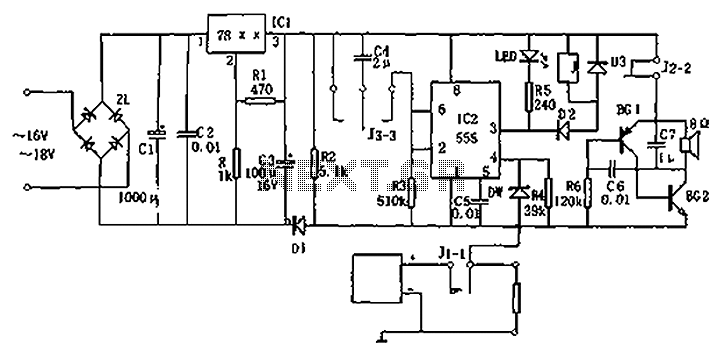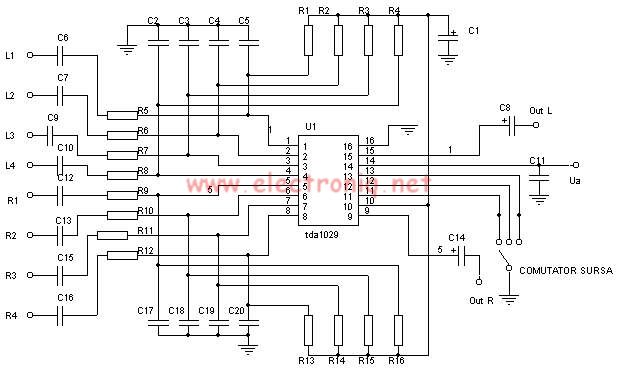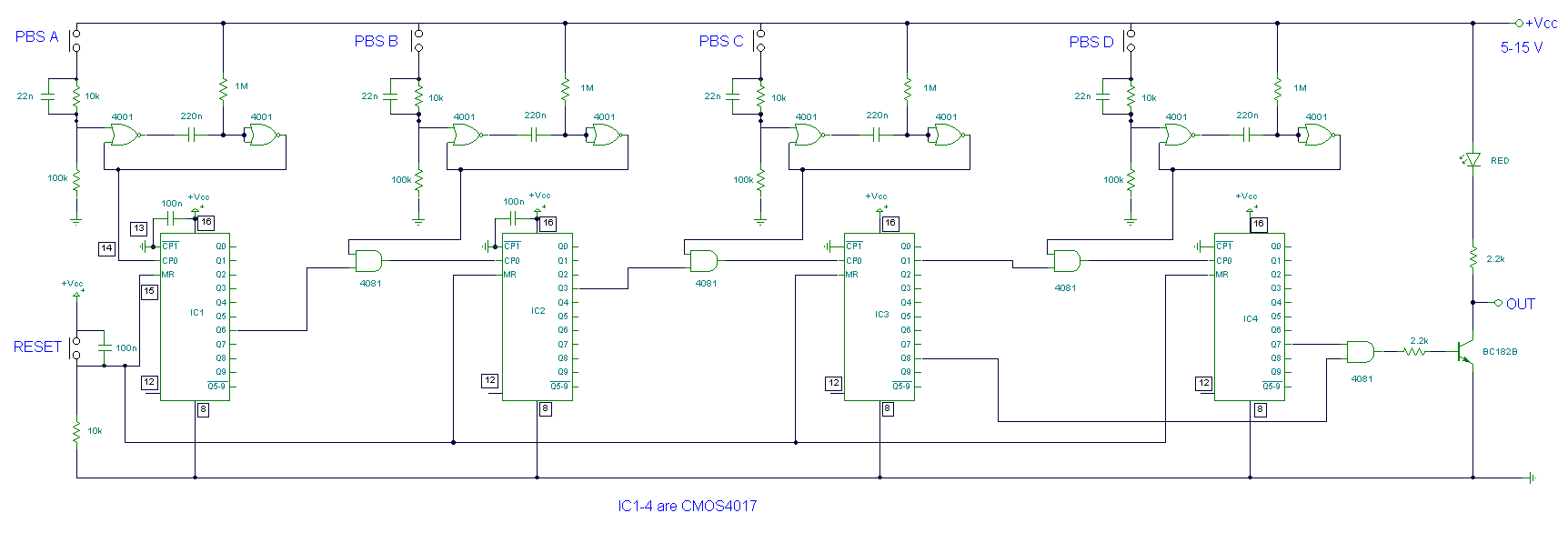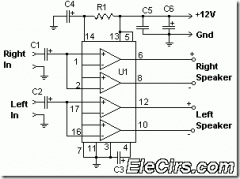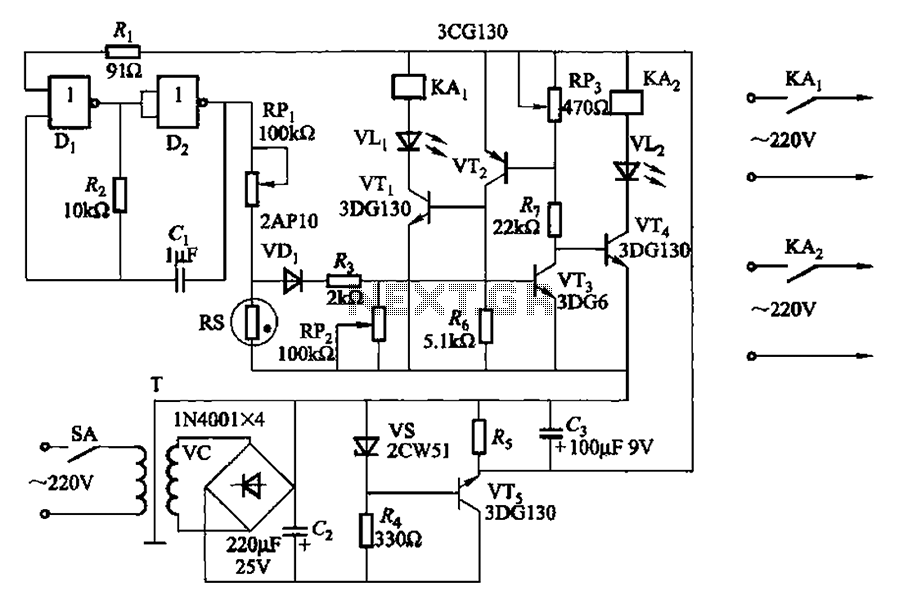
Speed Reaction Test Circuit
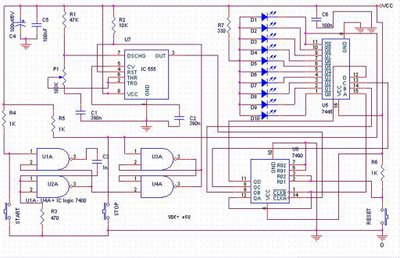
The speed test circuit is a simple design intended to measure a person's reaction time in a game. The operation of this peripheral is straightforward, facilitated by several integrated circuits, including a counter, timer IC, and decoder. The timer IC used is the 555, the decoder is the 7445, and the counter is the 7490. Logic ICs employed from U1A to U4A are 7400 series. The operation of the reaction speed testing tool begins when the start button is pressed, triggering the 555 IC to generate a series of pulses to the 7490 counter. As a result, LEDs numbered 1 to 10 will illuminate sequentially. When the stop button is pressed, the last LED will remain lit continuously. The oscillator generates a pulse every 20 milliseconds, allowing the player’s reaction time to be measured by observing which LED remains on. A new game can be initiated by pressing the reset button. With the component values specified in the schematic diagram, the circuit operates on a 5V power supply and draws a stabilized current of 120mA. The oscillator frequency can be adjusted using potentiometer P1, ranging from 10 to 80 Hz. Additionally, an LED can be connected with a 200-ohm resistor between the outputs of N3 and the positive voltage to serve as an indicator that the peripheral is in standby mode after the player presses the start button.
The speed test circuit is designed to assess human reaction time through a user-friendly interface. The core components include the 555 timer IC, which generates a precise timing sequence, and the 7490 decade counter, which counts the pulses output by the timer. The 7445 decoder translates the counter's binary output into a format suitable for driving the LEDs, allowing for a visual representation of the counting process.
When the circuit is powered on and the start button is pressed, the 555 timer is activated, producing a rapid succession of pulses. These pulses increment the count in the 7490 counter, which, in turn, activates the LEDs in a sequential manner. The illumination of the LEDs provides immediate feedback to the player, indicating the countdown to the reaction test.
Upon pressing the stop button, the last LED lit will remain illuminated, signaling the end of the test. The timing of the last LED provides a visual cue for the player to gauge their reaction time. The circuit's design ensures that the player can easily reset the game and begin a new round by pressing the reset button, which clears the counter and prepares the circuit for the next test.
The circuit's power requirements are modest, operating at 5V with a current draw of 120mA, making it suitable for battery operation or low-power applications. The adjustable frequency via potentiometer P1 allows for customization of the reaction test's difficulty, accommodating different skill levels.
Incorporating an additional LED with a 200-ohm resistor as an indicator enhances the user experience by providing a clear visual signal that the system is ready for the next round. This feature ensures that players are aware of the circuit's status without needing to monitor other components actively. Overall, this speed test circuit is an effective and engaging tool for measuring reaction times, suitable for various applications in both recreational and educational settings.Speed test circuit reaction of is simple planning. This circuit functions for game to test speed reaction of a man. Mode of the action of this peripheral is hardly easy to be comprehended. This thing is caused by this peripheral only lapped over by some Logical Integrated Circuit, counter, timer IC and decoder. Becoming timer IC to explain is IC 5 55. At the decoder we can apply IC 7445 and counter applies IC 7490. Logic IC applied at U1A until U4A is 7400. Following is mode of action from reaction speed testing tool. After the starting button is pushed, hence during a real quickly IC 555 giving some row of pulse towards IC chopper 7490. Effect [of] the thing is LED 1to 10 will turning on sequentially. Here in after, if the stopping button is pushed, a life last LED will be turning on continually. When oscillator awakening pulse of bell flamed to be finite a pulse will be yielded, for example every 20 md, hence countable player reaction time by seeing LED which is stay on.
New game can be made a fresh start, after RESET is pushed. By using component value which there is in diagram schematic, circuit will only consume source of the voltage is 5V and the current is 120mA stabilized. Oscillator frequency can set up by P1 between 10 to 80 Hz. When we wish LED attachment, can be attached a LED which is break even with resistor 200 ohms between outputs of N3 with positive voltage.
This LED will live as indicator that peripheral in stand-by condition after player buttons START. 🔗 External reference
The speed test circuit is designed to assess human reaction time through a user-friendly interface. The core components include the 555 timer IC, which generates a precise timing sequence, and the 7490 decade counter, which counts the pulses output by the timer. The 7445 decoder translates the counter's binary output into a format suitable for driving the LEDs, allowing for a visual representation of the counting process.
When the circuit is powered on and the start button is pressed, the 555 timer is activated, producing a rapid succession of pulses. These pulses increment the count in the 7490 counter, which, in turn, activates the LEDs in a sequential manner. The illumination of the LEDs provides immediate feedback to the player, indicating the countdown to the reaction test.
Upon pressing the stop button, the last LED lit will remain illuminated, signaling the end of the test. The timing of the last LED provides a visual cue for the player to gauge their reaction time. The circuit's design ensures that the player can easily reset the game and begin a new round by pressing the reset button, which clears the counter and prepares the circuit for the next test.
The circuit's power requirements are modest, operating at 5V with a current draw of 120mA, making it suitable for battery operation or low-power applications. The adjustable frequency via potentiometer P1 allows for customization of the reaction test's difficulty, accommodating different skill levels.
Incorporating an additional LED with a 200-ohm resistor as an indicator enhances the user experience by providing a clear visual signal that the system is ready for the next round. This feature ensures that players are aware of the circuit's status without needing to monitor other components actively. Overall, this speed test circuit is an effective and engaging tool for measuring reaction times, suitable for various applications in both recreational and educational settings.Speed test circuit reaction of is simple planning. This circuit functions for game to test speed reaction of a man. Mode of the action of this peripheral is hardly easy to be comprehended. This thing is caused by this peripheral only lapped over by some Logical Integrated Circuit, counter, timer IC and decoder. Becoming timer IC to explain is IC 5 55. At the decoder we can apply IC 7445 and counter applies IC 7490. Logic IC applied at U1A until U4A is 7400. Following is mode of action from reaction speed testing tool. After the starting button is pushed, hence during a real quickly IC 555 giving some row of pulse towards IC chopper 7490. Effect [of] the thing is LED 1to 10 will turning on sequentially. Here in after, if the stopping button is pushed, a life last LED will be turning on continually. When oscillator awakening pulse of bell flamed to be finite a pulse will be yielded, for example every 20 md, hence countable player reaction time by seeing LED which is stay on.
New game can be made a fresh start, after RESET is pushed. By using component value which there is in diagram schematic, circuit will only consume source of the voltage is 5V and the current is 120mA stabilized. Oscillator frequency can set up by P1 between 10 to 80 Hz. When we wish LED attachment, can be attached a LED which is break even with resistor 200 ohms between outputs of N3 with positive voltage.
This LED will live as indicator that peripheral in stand-by condition after player buttons START. 🔗 External reference
